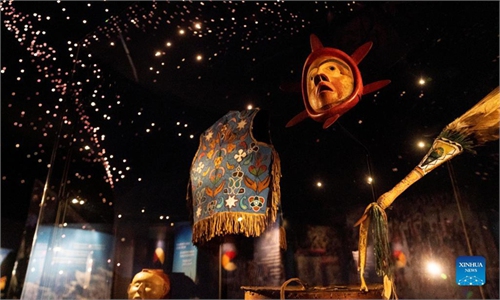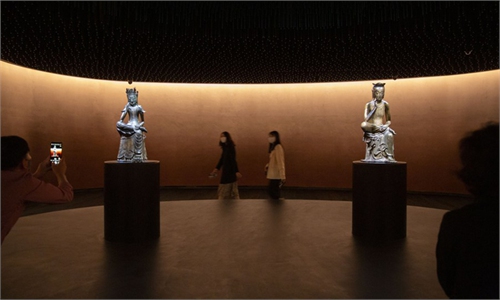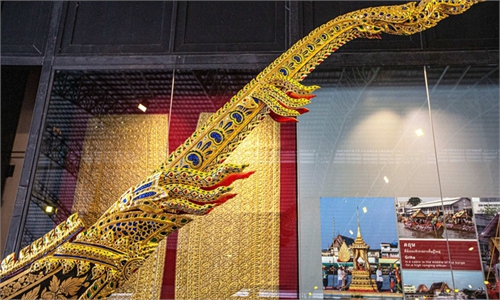ARTS / CULTURE & LEISURE
Mobile service brings history and art to special education school
Excitement was in the air at a special education school in Northwest China's Gansu Province last week when a "mobile museum" visited the campus.
Students gathered in front of colorful boards placed in the school's playground by the Museum of Gannan Tibetan Autonomous Prefecture in Gansu, which displayed images of treasured items from the museum's collection.
Chen Bingren, head of the museum's display department, was the curator of the one-day exhibition. With over 20 years of working in the museum industry, this was the first time Chen guided a tour for children with disabilities.
The Gannan special education school currently has 158 students, including children with hearing loss, learning disabilities and autism. Though many of them have difficulty talking, the curiosity in their sparkling eyes showed that they had a lot to say.
With the help of a sign-language teacher at the school, the discussion between Chen and the students went smoothly.
"What kind of pattern do you see here?" asked Chen, pointing at an image of an ancient pot on the board.
The children put their wrists together, repeatedly closing and opening their palms, to simulate a frog's mouth, as their way of describing the frog-shaped pattern.
Huang Baoping, an eighth-grader at the school with a hearing impairment, has a passion for drawing. As a big fan of art, he was excited for days after first learning of the exhibition.
Closely following Chen and the sign-language teacher, Huang kept asking questions like "What are the images on the pottery pieces?" and "Why did the ancient people draw things like that?"
Later on, he attended a pottery workshop that is part of the exhibition program. Huang made a lotus flower, because Chen had told him that ancient people in China liked to compare lotus flowers to people with noble characters.
Chen was amazed by the children's perception of art. "We prepared three patterns for them to imitate, but many children, like Huang, made creative works based on their own preferences and understanding of things," said Chen.
In recent years, museums across China have launched "mobile museum" services for grassroots communities, rural areas and remote mountainous regions. A combination of online and offline displays has also boosted museums.
For example, the Gannan museum, which was opened in 1986, has seen its visitor numbers multiply to about 60,000 per year. Of these, around 50 percent are from online exhibitions or exhibitions held outside the museum.
As the museum staff packed up the boards at the end of the day, the children didn't want them to leave. "When will you come again?" some of them asked.
Ma Yujiao, a teacher at the school, said that they have organized trips to local museums in the past but an exhibition held in the school felt different.
"Museums undertake the important functions of history and art education and cultural inheritance, so we have the important mission of spreading the power of museums to a wider audience," Chen said.
Students gathered in front of colorful boards placed in the school's playground by the Museum of Gannan Tibetan Autonomous Prefecture in Gansu, which displayed images of treasured items from the museum's collection.
Chen Bingren, head of the museum's display department, was the curator of the one-day exhibition. With over 20 years of working in the museum industry, this was the first time Chen guided a tour for children with disabilities.
The Gannan special education school currently has 158 students, including children with hearing loss, learning disabilities and autism. Though many of them have difficulty talking, the curiosity in their sparkling eyes showed that they had a lot to say.
With the help of a sign-language teacher at the school, the discussion between Chen and the students went smoothly.
"What kind of pattern do you see here?" asked Chen, pointing at an image of an ancient pot on the board.
The children put their wrists together, repeatedly closing and opening their palms, to simulate a frog's mouth, as their way of describing the frog-shaped pattern.
Huang Baoping, an eighth-grader at the school with a hearing impairment, has a passion for drawing. As a big fan of art, he was excited for days after first learning of the exhibition.
Closely following Chen and the sign-language teacher, Huang kept asking questions like "What are the images on the pottery pieces?" and "Why did the ancient people draw things like that?"
Later on, he attended a pottery workshop that is part of the exhibition program. Huang made a lotus flower, because Chen had told him that ancient people in China liked to compare lotus flowers to people with noble characters.
Chen was amazed by the children's perception of art. "We prepared three patterns for them to imitate, but many children, like Huang, made creative works based on their own preferences and understanding of things," said Chen.
In recent years, museums across China have launched "mobile museum" services for grassroots communities, rural areas and remote mountainous regions. A combination of online and offline displays has also boosted museums.
For example, the Gannan museum, which was opened in 1986, has seen its visitor numbers multiply to about 60,000 per year. Of these, around 50 percent are from online exhibitions or exhibitions held outside the museum.
As the museum staff packed up the boards at the end of the day, the children didn't want them to leave. "When will you come again?" some of them asked.
Ma Yujiao, a teacher at the school, said that they have organized trips to local museums in the past but an exhibition held in the school felt different.
"Museums undertake the important functions of history and art education and cultural inheritance, so we have the important mission of spreading the power of museums to a wider audience," Chen said.



